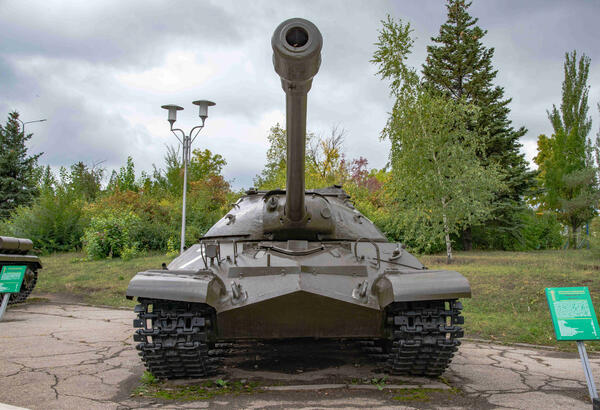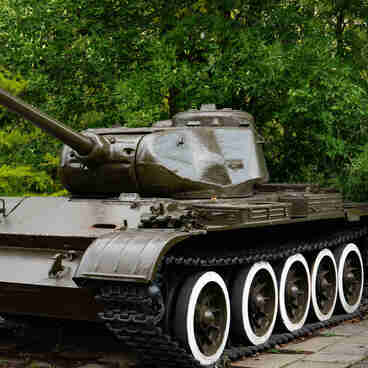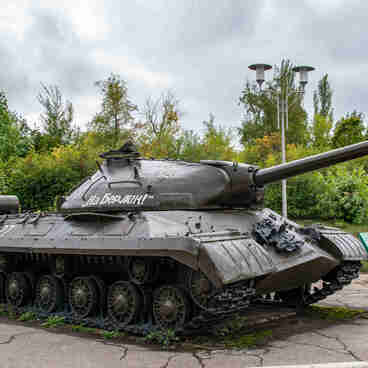The T-10 heavy tank was developed at the Kirov Plant No. 178 in Chelyabinsk under the leadership of Joseph Yakovlevich Kotin. It entered service in 1953. The T-10 was a development of the IS-3 tank series, from which it borrowed the shape of the hull with the characteristic “pike nose” and turret.
The tank’s hull was made up of forged and pressed armor plates, the most powerful of them — the frontal, 120 mm thick — was positioned at an angle of 57 degrees. The plates were joined together by welding. Composite plates were used for the sides, those were inclined and bent in the lower part armor plates of up to 80 mm thick.
The 122mm D-25T cannon was equipped with a ramming mechanism, so that its rate of fire was up to four rounds per minute. The rate of fire of the IS-3 tanks, which entered service in 1945, was three rounds per minute.
The tank’s auxiliary weapons were two large-caliber machine guns — the 12.7mm Degtyaryov-Shpagin guns (DShKT): one coaxial, and the second, the anti-aircraft gun, was mounted on the turret. These machine guns proved themselves in terms of rate of fire, ease of use and armor penetration capability.
After the more powerful Vladimirov machine guns (KPV) were fitted on the T-10M, the DShKT remained the main tank machine gun in many countries of Eastern Europe. The first T-10s carried high-explosive and armor-piercing shells with a total of only 30 rounds in the ammunition stowage in the turret and on the bottom of the tank.
The combat vehicle carried 1000 rounds for the Degtyaryov-Shpagin machine guns. Of these, 600 for the coaxial machine gun were stored in boxes in the tank, 150 — in special pencil cases, they were intended for anti-aircraft guns. The rest were kept in ordinary air-tight ammo containers.
The use of 14.5mm KPVT machine guns led to a reduction in ammunition to 744 rounds. The ammunition included armor-piercing tracer rounds and a number of machine gun tracer rounds. The T-10 was fitted with the V-12-5 atmospheric diesel engine, the most modern and powerful in those years. It was the development of the V-2 unit.
The engine was built on the basis of a 12-cylinder V-shaped block with liquid cooling. With a working volume of 38.8 liters, the engine produced 700 hp. Subsequently, the engine was boosted to 750 hp, which was reflected in the modified designation V-12-6.
The tank was upgraded many times. In total, about 8 thousand units were manufactured, but they were intended for export. These tanks were not used in combat operations. In 1993, they were retired from service with the Russian Army.
The tank’s hull was made up of forged and pressed armor plates, the most powerful of them — the frontal, 120 mm thick — was positioned at an angle of 57 degrees. The plates were joined together by welding. Composite plates were used for the sides, those were inclined and bent in the lower part armor plates of up to 80 mm thick.
The 122mm D-25T cannon was equipped with a ramming mechanism, so that its rate of fire was up to four rounds per minute. The rate of fire of the IS-3 tanks, which entered service in 1945, was three rounds per minute.
The tank’s auxiliary weapons were two large-caliber machine guns — the 12.7mm Degtyaryov-Shpagin guns (DShKT): one coaxial, and the second, the anti-aircraft gun, was mounted on the turret. These machine guns proved themselves in terms of rate of fire, ease of use and armor penetration capability.
After the more powerful Vladimirov machine guns (KPV) were fitted on the T-10M, the DShKT remained the main tank machine gun in many countries of Eastern Europe. The first T-10s carried high-explosive and armor-piercing shells with a total of only 30 rounds in the ammunition stowage in the turret and on the bottom of the tank.
The combat vehicle carried 1000 rounds for the Degtyaryov-Shpagin machine guns. Of these, 600 for the coaxial machine gun were stored in boxes in the tank, 150 — in special pencil cases, they were intended for anti-aircraft guns. The rest were kept in ordinary air-tight ammo containers.
The use of 14.5mm KPVT machine guns led to a reduction in ammunition to 744 rounds. The ammunition included armor-piercing tracer rounds and a number of machine gun tracer rounds. The T-10 was fitted with the V-12-5 atmospheric diesel engine, the most modern and powerful in those years. It was the development of the V-2 unit.
The engine was built on the basis of a 12-cylinder V-shaped block with liquid cooling. With a working volume of 38.8 liters, the engine produced 700 hp. Subsequently, the engine was boosted to 750 hp, which was reflected in the modified designation V-12-6.
The tank was upgraded many times. In total, about 8 thousand units were manufactured, but they were intended for export. These tanks were not used in combat operations. In 1993, they were retired from service with the Russian Army.





